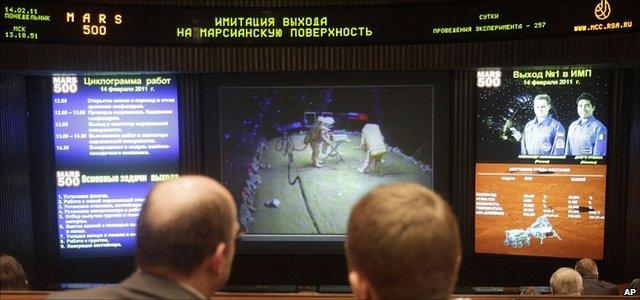Mars500 crew 'walk on Mars' on simulated mission
- Published

Alexander Smoleevskiy and Diego Urbina walk on the "surface of Mars"
Two men wearing spacesuits have walked across a sandpit at a Moscow institute in a simulation of a mission to Mars.
The pair - both volunteers - have spent eight months with four other men locked away in a series of windowless steel tubes representing a spacecraft.
The Mars500 project is trying to find out how the human mind and body would cope on a long-duration spaceflight.
Russian Alexander Smoleevskiy and Italian Diego Urbina planted flags on their pretend planet.
One flag was for Russia, another for China and a third for the European Space Agency (Esa).
They then undertook some virtual experiments with the assistance of a robot rover, with the whole activity lasting an hour and 12 minutes.
The walk was overseen by Mission Control Moscow which normally deals with events on the International Space Station (ISS).
"We have made great progress today," commented Vitaly Davydov, the deputy head of the Russian Federal Space Agency, who was watching a video feed of the two men. All systems have been working normally."
The Mars500 venture is being run by the Institute of Biomedical Problems (IMBP), with the participation of Esa.
Smoleevskiy and Urbina were said to have "landed" on the Red Planet on Saturday.
In reality, they had merely moved to another compartment in the cramped modular buildings set up at the institute.
A Chinese national, Wang Yue, had joined them, and he will perform one of two further surface walks planned in the coming days.
Three other volunteers - Russians Alexey Sitev and Sukhrob Kamolov, and Frenchman Romain Charles - are said, in the context of the experiment, to be still in orbit above Mars. Again, in reality, they are just a few metres away in the series of interconnected tubes.
The life the six men are experiencing is quite different from that on the ISS where vehicles and their passengers come and go. The station is a busy place and communication with the ground is also possible in real-time for its residents.
On the Mars500 ship, however, life is much more restricted. The messages these pretend explorers send to the scientists outside their simulation craft have a 20-minute delay on them to mimic the sort of time lag radio signals would build up as they crossed the vastness of space between Mars and Earth.
Much of their time is taken up running through an experiment programme devised by scientists from Russia and across the EU. Several of these experiments look at how the stress of the participants' predicament affects their mental and physical states.
The landing operations are brief moments of excitement for the team. The Orlan suits are of the type worn by real cosmonauts. In this bulky gear, the Marswalkers have drill to get below their simulation surface and do virtual analyses on the samples they pull up.
Mars500 is so called because it follows broadly the duration of a possible human Mars mission in the future using conventional propulsion: 250 days for the trip to the Red Planet, 30 days on the Martian surface and 240 days for the return journey, totalling 520 days. (In reality, it would probably take a lot longer than this).

Events were followed at Moscow Mission Control
A real mission to Mars is still decades away. The challenges involved are immense, both technologically and in terms of the budget required. It would probably cost tens of billions of dollars to mount such an endeavour.
Scientists would need to find a way of protecting the crew from space radiation. On the ISS, this is not so much of a problem because the Earth's magnetic field helps shield the orbiting platform from damaging, high-energy particles emanating from the Sun and deep space.
A trip to Mars would take eighteen months
Russian and European space officials are already talking about repeating the experiment on the space station itself. Such an experiment would add in the complexity of having to cope with weightlessness as well - something the Mars500 participants do not face.
"It is in the mind of many people now to do something like this eventually on the ISS," explained Dr Martin Zell, who runs Europe's science programme on the orbiting platform.
"You can do it with different levels of sophistication and difficulty. It will probably start with a kind of temporary disconnect of the ISS crew from communications, when, for a certain period, perhaps just days initially, they have to operate on their own.
"But the ultimate simulation on the ISS would be to have a module - perhaps free-flying, perhaps connected - with maybe a crew of three isolated from the rest of the station with their own resources for six months to year - much like in Mars500; and again with reduced and realistic communication," he told BBC News.
- Published2 February 2011
- Published3 June 2010
- Published3 June 2010
- Published3 June 2010